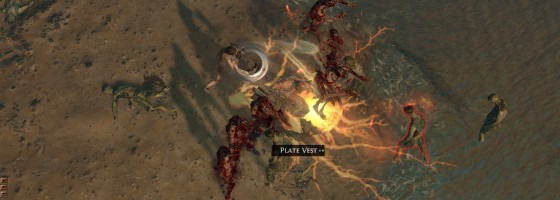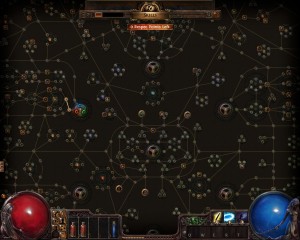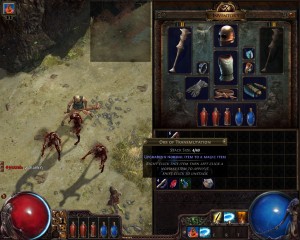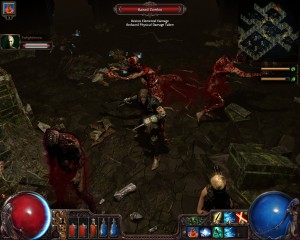ARPGs appear to be in yet again, thanks to the releases of Diablo 3 and Torchlight 2 last year. But while gamers were arguing about which one was the best, there was another in development. Path of Exile by Grinding Gear Games may hold the record for longest beta period in recent time. As the game was first started in 2010, closed beta began in August 2011 and they just opened the beta last month.
Having spent time in the closed beta and recently playing it again, we can finally take a look at a free to play ARPG, and that’s not the only radical element of the game.
The Long Winding Road:
Path of Exile takes a cue from the original Diablo and takes the genre back to the dark gritty days. The game begins with the player surviving exile from their home land and arriving in Wraeclast – to fend for themselves in a dangerous world.
When you start playing, you’ll create your character from six archetypes that are categorized by their attribute focus. You have strength, dexterity, intelligence, strength- intelligence, dexterity-intelligence and strength-dexterity. Your starting class determines what items you’ll receive from quests and your position on the skill tree.
Path of Exile‘s skill tree is perhaps what is the most publicize aspect of the game, featuring a multi-screen spanning tree that is sure to confound even the most hardened APRG fan on first look.
The tree itself is made up of all passive abilities. With abilities ranging from smaller nodes that provide attribute increases, increase weapon damage and many more. Bigger nodes provide even more bonuses, and the biggest ones on the fringe or middle are character or skill altering, one example of these skills – your character will no longer miss on any attacks, but will never perform a critical hit again.
The whole thing is definitely daunting at first glance, but becomes easier to read over time.
Each class’s starting position is near skills that are directly useful to the class.
There are also plenty of repeats among the tree allowing you multiple paths in how to define your character.
And since these skills are not locked behind a class, you have complete freedom in building your character.
Now you’re probably wondering if the skill tree is only made up of passive affects, then how does the player get new abilities? Well that’s where POE’s loot and item system comes into play.
Slotting For Success:
As in any ARPG, loot is vital to your success in POE and comes in different rarities, quality (affects stats of the gear) and most importantly slots.
As you play POE, you’ll find skill gems ether from drops or as quest rewards. Each skill gem provides the player with a skill they can use in combat and are categorized by an attribute: blue, red and green or intelligence, strength and dexterity respectively.
Obviously, blue gems are normally spells, while red are combat tactics for instance. But there are a huge number of skills for the player to find and adapt to their play style. Using said skills requires you to put them into your equipment, which is where the slots come into play. Skill gems also level up while slotted making them better, with limits dependent on how high your attributes are.
Since every piece of gear has their slots randomized on generation, you’ll need to plan around what gear to wear and what skills to use. The gear variety is very well done with pieces viable for all six classes.
Making things even more interesting, you’ll start finding gems that act as modifiers to other gems. To make use of these gems you’ll have to find gear that has slots that are linked together.
Now all this sounds complex compared to other APRGS on the market, and even more surprising by the fact that POE is free to play.
Eloquently Gritty:
For a F2P game, POE shows a lot of care and attention to detail. The hardcore league for example ranks players based on how far they can go and what their level is. With supposed rewards and bragging rights on the line. But best still is that dying in hardcore simply drops your character down to the standard league. This way it keeps the threat of death high, without the risk of throwing your character down the drain.
The micro transaction side of POE also deserves mention for being one of the best examples I’ve seen yet since League of Legends. Like all F2P titles, POE has the standard quality of life purchases: more stash space and character slots. But the bulk of the available purchases are all aesthetic effects. From new animations for your characters, special graphical affects that can be applied to loot and even cute little pets to cheer you on while you’re fighting.
But the best category and one that I’m really tempted to get are spell graphics modifiers. What these do is change the graphics for specific spells to make them look different. For instance: instead of raising an army of skeletons with the raise skeleton skill, you could raise an army of animated statues.
Now these effects do not change anything about the skill, other than the graphics used and I think these are a great way to encourage spending money, without forcing the player. This innovative approach allows players to engage in a more dynamic and strategic market system, enhancing their gameplay experience. The use of poe currency not only facilitates the acquisition of essential items but also enables the customization of skills through aesthetic changes, offering a non-intrusive monetization model that respects player choice.
Overall POE is a great game but it’s not without its problems. The actual combat lacks the flair that we see from Diablo 3 and Torchlight 2 as you’re going to mainly use your primary attack for the bulk of combat.
This in turn makes POE’s combat one of the more repetitive examples seen in the genre. The animation department is definitely lacking, with very few death and attack animations.
Part of the reason for the repetitiveness is the skill gem system. If you don’t get lucky with finding new gems, then actual changes to your combat routine will come few and far between. The classes themselves are just basic templates, with all the customization coming from loot and skill gems. This is both good and bad in the way that everyone can specialize in everything, but leaves the early gameplay very basic.
Besides the skill tree, POE’s other unique system is how items are bartered. Instead of finding gold, you trade in weapons and equipment for scrolls and other item affecting modifiers that act as the game’s currency. The system is unique, but could be explained better to new people.
The other problem is that with the whole skill tree system, POE doesn’t have that instant gratification you get from other ARPGS. The bulk of the progression is tied to long term: Finding gear with the slots you need, working towards specific nodes, leveling up your gems, etc. Because of this, POE doesn’t have that pick up and play element that you get from a game like Torchlight 2 or Diablo 3.
Lastly, keep in mind that the game is still considered in beta and there are reports of network issues and being kicked from the server. I lost several hardcore characters over the weekend due to a sudden case of lag causing my character to take damage when there was no one near him.
With that said Path of Exile even in open beta, is still a great game. It’s amazing the quality and thought the designers have put into a F2P game.
Especially given how far POE manages to distinguish itself compared to other ARPGs that have to be paid for.
Given that POE isn’t even considered out for release yet, I’m curious to see what else is going to be added, as the game feels done mechanically speaking.
For people looking for a new ARPG play, or didn’t quite get what they were looking for last year, POE is definitely a game to look into.





